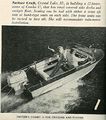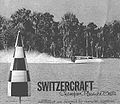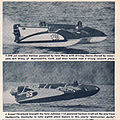Difference between revisions of "Switzer"
(added 1959 article) |
(added 1957 ad) |
||
| (One intermediate revision by the same user not shown) | |||
| Line 15: | Line 15: | ||
'''The Switzer-Craft U-4 (Flying Wing) Story''' | '''The Switzer-Craft U-4 (Flying Wing) Story''' | ||
| − | THE BOATING INDUSTRY has astronauts | + | THE BOATING INDUSTRY has astronauts tooâunshackled and undaunted by the supposed limitations of time and space. Although modesty may make the Switzer brothers shudder at likening them to Alan Shepard, Gus Grissom, and the others eager and able to ride the fastest craft, however unique in design, the comparison comes instantly to mind. For Switzer Craft boat company's still unnamed new model, identified only by the American Power Boat Association code U-4, and its designer, 35 year-old David Switzer of Crystal Lake, Illinois, wrote watercraft history on June 25 at Lake Winnebago, Wisconsin.<br><br> |
When the MILWAUKEE SENTINEL announced the 13th annual running of the Winnebagoland Outboard Marathon and decided to include, for the first time, a pleasure boat category, Switzer Craft did not have a boat to enter in the unlimited class. This left exactly two weeks to design, build, test and enter a new boat for the race. The opportunity was too attractive to pass up, so Dave Switzer simply decided to use some of the ideas he and other designers have toyed with for years but had considered almost too revolutionary to employ. There was not even time enough to put the boat properly on the drawing board. He drew only a sketch and developed the design while the boat was in the building.<br><br> | When the MILWAUKEE SENTINEL announced the 13th annual running of the Winnebagoland Outboard Marathon and decided to include, for the first time, a pleasure boat category, Switzer Craft did not have a boat to enter in the unlimited class. This left exactly two weeks to design, build, test and enter a new boat for the race. The opportunity was too attractive to pass up, so Dave Switzer simply decided to use some of the ideas he and other designers have toyed with for years but had considered almost too revolutionary to employ. There was not even time enough to put the boat properly on the drawing board. He drew only a sketch and developed the design while the boat was in the building.<br><br> | ||
"We were inspired by necessity," Dave says, "to try many new ideas in the construction features. We chose plywood with which to form the twin catamaran hulls but in order to save weight and yet provide the over-all structural strength required, conventional framing was replaced with Reichhold's rigid urethane foam. Except for the cockpit space, both hulls were entirely filled with the rigid foam. The use of foam has a twofold advantage in that it supplies the strength and also makes the boat unsinkable and free from the usual hazards of punctures.<br><br> | "We were inspired by necessity," Dave says, "to try many new ideas in the construction features. We chose plywood with which to form the twin catamaran hulls but in order to save weight and yet provide the over-all structural strength required, conventional framing was replaced with Reichhold's rigid urethane foam. Except for the cockpit space, both hulls were entirely filled with the rigid foam. The use of foam has a twofold advantage in that it supplies the strength and also makes the boat unsinkable and free from the usual hazards of punctures.<br><br> | ||
| Line 37: | Line 37: | ||
'''Model Information''' | '''Model Information''' | ||
<gallery> | <gallery> | ||
| − | File:Switzercraftbb001.jpg|1958 to 1962 Switzer-Craft models | + | File:Switzercraftbb001.jpg|1958 to 1962 Switzer-Craft outboard boat models |
| − | File:Switzercraftbb002.jpg|1965 to 1969 Switzer-Craft outboard models | + | File:Switzercraftbb002.jpg|1965 to 1969 Switzer-Craft outboard boat models |
</gallery> | </gallery> | ||
| + | |||
| + | '''1957 Information''' | ||
| + | <gallery> | ||
| + | File:Switzercrafta57001.jpg|1957 Switzer-Craft Boats Article | ||
| + | File:Switzercrafta57002.jpg|1957 Switzer-Craft Boats Ad | ||
| + | </gallery> | ||
| Line 98: | Line 104: | ||
[[Category:Sheet Plywood]] | [[Category:Sheet Plywood]] | ||
[[Category:Fiberglass]] | [[Category:Fiberglass]] | ||
| + | [[Category:VIP]] | ||
Latest revision as of 13:43, 13 May 2021
Switzer-Craft, Inc.
Crystal Lake, Illinois
An earlier location was McHenry, Illinois.
The Switzer-Craft U-4 (Flying Wing) Story
THE BOATING INDUSTRY has astronauts tooâunshackled and undaunted by the supposed limitations of time and space. Although modesty may make the Switzer brothers shudder at likening them to Alan Shepard, Gus Grissom, and the others eager and able to ride the fastest craft, however unique in design, the comparison comes instantly to mind. For Switzer Craft boat company's still unnamed new model, identified only by the American Power Boat Association code U-4, and its designer, 35 year-old David Switzer of Crystal Lake, Illinois, wrote watercraft history on June 25 at Lake Winnebago, Wisconsin.
When the MILWAUKEE SENTINEL announced the 13th annual running of the Winnebagoland Outboard Marathon and decided to include, for the first time, a pleasure boat category, Switzer Craft did not have a boat to enter in the unlimited class. This left exactly two weeks to design, build, test and enter a new boat for the race. The opportunity was too attractive to pass up, so Dave Switzer simply decided to use some of the ideas he and other designers have toyed with for years but had considered almost too revolutionary to employ. There was not even time enough to put the boat properly on the drawing board. He drew only a sketch and developed the design while the boat was in the building.
"We were inspired by necessity," Dave says, "to try many new ideas in the construction features. We chose plywood with which to form the twin catamaran hulls but in order to save weight and yet provide the over-all structural strength required, conventional framing was replaced with Reichhold's rigid urethane foam. Except for the cockpit space, both hulls were entirely filled with the rigid foam. The use of foam has a twofold advantage in that it supplies the strength and also makes the boat unsinkable and free from the usual hazards of punctures.
"Wind pressures have a tendency to make a boat unmanageable. The design of the U-4 is intended to convert these wind pressures into an asset in stabilizing the boat at high speeds. In addition, we have reversed the tradition that boats should be bulkier in the bow and slender at the stern. The U-4 is slender at the bow and bulkier in the stem, a design which might be said to resemble a dart. In spite of its size, almost 19' long, 8' wide and 50" high, the U-4 sweeps through the water almost soundlessly because the two 80-hp Mercury outboard engines are shrouded by the design of the hull."
Lake Winnebago in mid-Wisconsin has a reputation of being one of the roughest and most unpredictable bodies of water in the United States. Its surface can produce a bewildering variety of chop and waves at the twist of a weathervane, their violence amplified by the fact that the lake is only 21' deep at its deepest part. The wind-whipped lake was at its challenging best on Sunday, June 25, when the starting gun went off. The race ran straight north up the lake from Fond du Lac to Neenah and return, a distance of 65 miles. The U-4, in the water for the first time only two days before, was deep in the pack of 46 pleasure boats at the running start. With Bob Switzer at the wheel and brother Dave riding as co-pilot, the eye-catching catamaran pushed into the lead within minutes of the start. According to the helicopter pilot and cameraman who were trying to take its picture but could only follow it up the course, the U-4 hit speeds up to 80 m.p.h. It was officially credited for covering the 65 mile course in 58 minutes at the average speed of 67.13 miles per hour. The U-4 swept everything off the lake to finish an easy first despite a hole in the center section which caused it to lose speed during the latter part of the race. As designer, Dave, explains, "We did not know how the boat would react to punishment and the place at which it was damaged was improperly stressed. Naturally, this will be corrected in future production models."
When the U-4 reaches peak speeds on its two-step twin hulls, it actually becomes airborne and leaps as much as 30 to 60 feet, getting lift from the air but returning to the water for its drive, it is the tremendous pressure generated at speeds up to 80 m.p.h. which blew a hole in the airfoil center section during the race.
People have described the U-4 as having the beauty and grace of a large swan. The grace, of course, comes from the hand of a skilled designer, but a good portion of the the beauty can be attributed to other new developments which were incorporated into the U-4. The gleaming white portion of the hull is a pigmented epoxy plastic coating and the natural finish is a clear polyester supplied by RCI. Epoxy and polyester finishes, because of their tough, durable properties, are gaining considerable popularity in the marine field and the U-4 was an excellent example.
Although this was the first year that the Outboard Marathon included a pleasure boat category, the pleasure boat race turned out to be quite a bonanza for Switzer Craft. In addition to the U-4 winning 1st place in the unlimited Class 5, a 1961 Switzer Craft Shooting Star driven by John DiPietra of Chicago, former California state water ski champion, placed 1st in Class 4. A 1957 Shooting Star driven by Ralph Kozan of Chicago placed 1st in Class 3 and Jerry Marunde of McHenry. Illinois drove a 14' Switzer Craft runabout to 4th place in Class 2. It is interesting to note that boats of catamaran design placed 1st, 2nd, 3rd, and 4th in the unlimited class. All four were driven by crack drivers and Bob Switzer, himself, is former National Stock Utility Outboard Racing Champion.
It might he said that the Switzer Craft Company of Crystal Lake Illinois is somewhat of a family affair. Formed in 1946 when Dave Switzer completed his service in the U.S. Navy Air Force, the company is headed by Dave's father, Russell Switzer as President, while his mother, Roma Switzer, is treasurer. Bob Switzer handles most of the company's test driving chores and is vice-president in charge of publicity. If Switzer Craft continues to rack up records like the Winnebagoland Marathon. Bob Switzer's job should be pretty easy front now on.
Written for RCI by GUM! (September 1961)
Story & Info:
Model Information
1957 Information
1958 Information
1959 Information
1960 Information
1960 Switzer-Craft Shooting Star Mercury 800 Test
Various Switzer Flying Wings



























